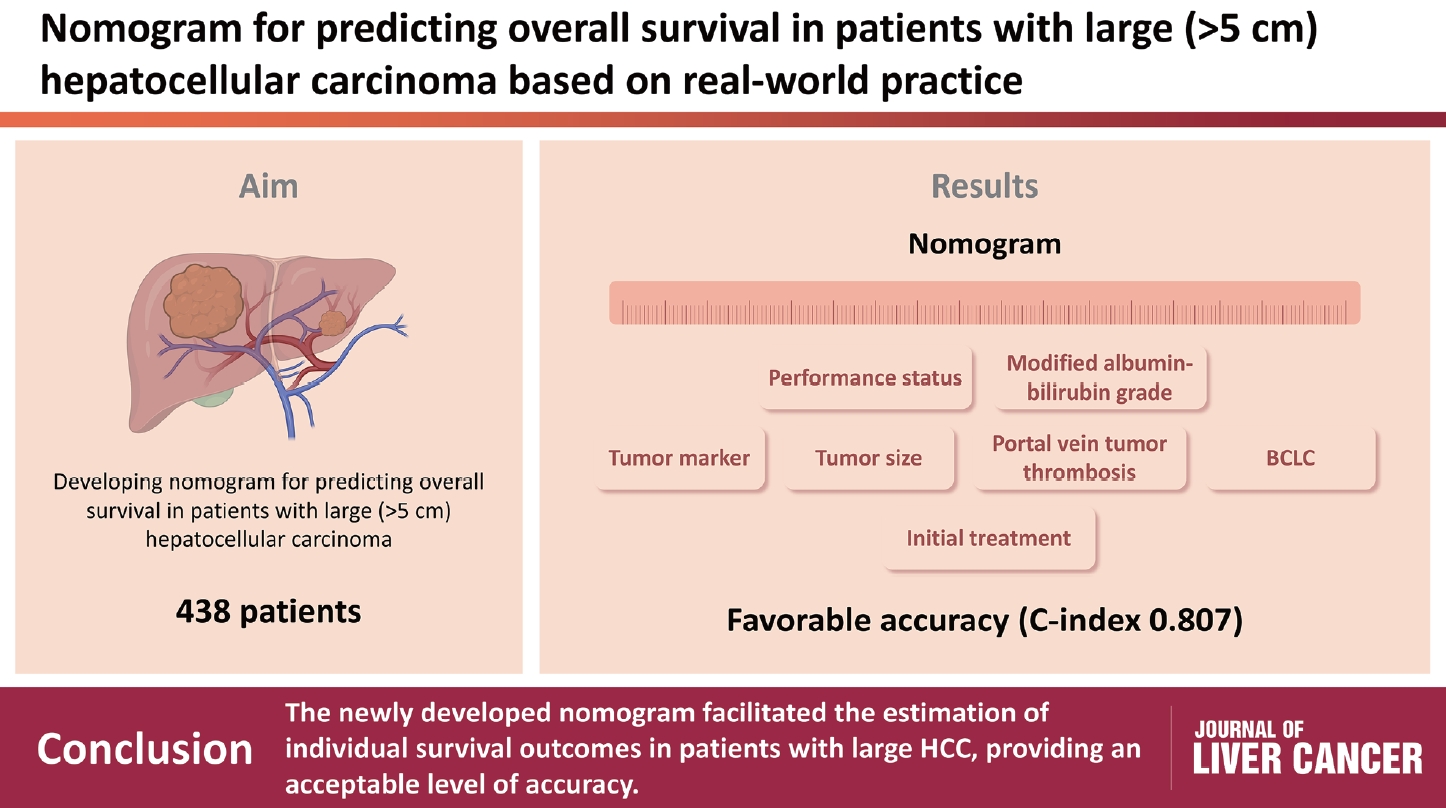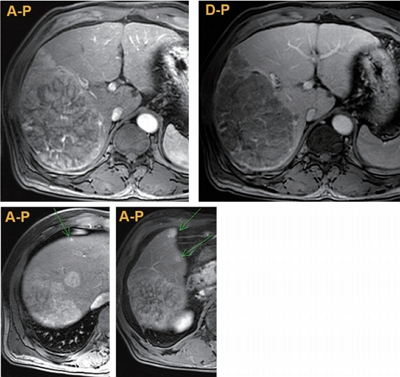Search
- Page Path
- HOME > Search
Letter to the Editor
- Letter regarding “Feasibility of additional radiotherapy in patients with advanced hepatocellular carcinoma treated with atezolizumab plus bevacizumab”
- Sun Hyun Bae, Hee Chul Park
- J Liver Cancer. 2023;23(2):402-404. Published online September 8, 2023
- DOI: https://doi.org/10.17998/jlc.2023.08.18
- 685 Views
- 33 Downloads

Original Article
- Nomogram for predicting overall survival in patients with large (>5 cm) hepatocellular carcinoma based on real-world practice
- Nalee Kim, Jeong Il Yu, Hee Chul Park, Jung Yong Hong, Ho Yeong Lim, Myung Ji Goh, Yong-Han Paik
- J Liver Cancer. 2023;23(2):350-361. Published online September 6, 2023
- DOI: https://doi.org/10.17998/jlc.2023.08.10

- 827 Views
- 46 Downloads
- 1 Citation
-
 Abstract
Abstract
 PDF
PDF Supplementary Material
Supplementary Material - Background/Aim
Patients with large (>5 cm) hepatocellular carcinoma (HCC) have limited treatment options, thus necessitating the identification of prognostic factors and the development of predictive tools. This study aimed to identify prognostic factors and to construct a nomogram to predict survival outcomes in patients with large HCC.
Methods
A cohort of 438 patients, who were diagnosed with large HCC at a tertiary hospital between 2015 and 2018, was analyzed. Cox proportional hazards models were used to identify key prognosticators of overall survival (OS), and an independent set of prognostic factors was used to develop a nomogram. The discrimination and calibration abilities of the nomogram were assessed and internal validation was performed using cross-validation and bootstrapping methods.
Results
During a median follow-up of 9.3 months, the median OS was 9.9 months, and the 1-year OS rate was 43.9%. Multivariable Cox regression analysis revealed that performance status, modified albumin-bilirubin grade, tumor size, extent of portal vein tumor thrombosis, and initial treatment significantly affected OS. The newly developed nomogram incorporating these variables demonstrated favorable accuracy (Harrell’s concordance index, 0.807).
Conclusions
The newly developed nomogram facilitated the estimation of individual survival outcomes in patients with large HCC, providing an acceptable level of accuracy. -
Citations
Citations to this article as recorded by- Prognostic Role of Basal Serum Alpha-Fetoprotein in Patients with Hepatocellular Carcinoma Suitable for Curative Treatment
Stefano Mazza, Chiara Frigerio, Daniele Alfieri, Aurelio Mauro, Francesca Torello Viera, Davide Scalvini, Chiara Barteselli, Carmelo Sgarlata, Letizia Veronese, Marco Bardone, Laura Rovedatti, Simona Agazzi, Elena Strada, Lodovica Pozzi, Marcello Maestri,
Medicina.2024; 60(5): 692. CrossRef
- Prognostic Role of Basal Serum Alpha-Fetoprotein in Patients with Hepatocellular Carcinoma Suitable for Curative Treatment

Case Reports
- Radiation-induced Myositis after Proton Beam Therapy to Huge Hepatocellular Carcinoma
- Jihye Kim, Gyu Sang Yoo, Dong Hyun Sinn, Hee Chul Park, Kwang Cheol Koh
- J Liver Cancer. 2019;19(2):136-142. Published online September 30, 2019
- DOI: https://doi.org/10.17998/jlc.19.2.136

- 6,204 Views
- 120 Downloads
- 2 Citations
-
 Abstract
Abstract
 PDF
PDF - Proton beam therapy (PBT) is one of the advances in radiotherapy techniques, which enables dose escalation with lower probability of radiation-induced liver or gastrointestinal injuries. However, the chest wall proximal to the tumor can be affected by high dose irradiation. Here, we report on a 58-year-old male patient who presented with huge hepatocellular carcinoma, received treatment with transarterial chemoembolization and PBT, and developed severe chest wall pain due to radiation-induced myositis. The patient’s symptoms were controlled by oral steroids.
-
Citations
Citations to this article as recorded by- Pectoralis Major Radiation Myonecrosis After Lung Stereotactic Body Radiation Therapy
Jason Gurewitz, Anand Mahadevan, Benjamin T. Cooper
Practical Radiation Oncology.2024; 14(3): 189. CrossRef - Current role of proton beam therapy in patients with hepatocellular carcinoma
Gyu Sang Yoo, Jeong Il Yu, Hee Chul Park
International Journal of Gastrointestinal Intervention.2021; 10(4): 175. CrossRef
- Pectoralis Major Radiation Myonecrosis After Lung Stereotactic Body Radiation Therapy

- A Case of Advanced Hepatocellular Carcinoma with Portal Vein Tumor Invasion that Showed Favorable Prognosis after Combined External Radiation Therapy and Sorafenib Therapy
- Namyoung Paik, Dong Hyun Sinn, Hee Chul Park, Woo Kyung Jeong, Min Sun Kim, Ji Hye Kim, Bumhee Yang
- J Liver Cancer. 2016;16(2):134-138. Published online September 30, 2016
- DOI: https://doi.org/10.17998/jlc.16.2.134
- 1,007 Views
- 6 Downloads
-
 Abstract
Abstract
 PDF
PDF - A prognosis of hepatocellular carcinoma (HCC) with portal vein tumor thrombosis (PVTT) is dismal that the median survival is 2 to 4 months without treatment. Sorafenib, the standard regimen of advanced HCC, can prolong median survival only 1.5 months. A 50-year-old man with a history of chronic hepatitis B was diagnosed advanced HCC with PVTT. By a multidisciplinary medical team approach, the combination of 3-demensional conformal radiation therapy with sequential sorafenib was challenged. 4 months after initiation of treatment, he achieved partial response as modified response evaluation criteria in solid tumors criteria. Sorafenib was continued so far, and stable disease has been maintained up to now, without significant adverse effect.

Review Articles
- Role of Radiation Therapy as an Ablative Modality for Hepatocellular Carcinoma
- Hee Chul Park
- Journal of the Korean Liver Cancer Study Group. 2013;13(2):114-122. Published online September 30, 2013
- DOI: https://doi.org/10.17998/jlc.13.2.114
- 953 Views
- 6 Downloads
-
 Abstract
Abstract
 PDF
PDF - Before the introduction of radiation therapy (RT) in the clinical management guidelines for hepatocellular carcinoma (HCC), radiation was used not very frequently in the course of HCC management. According to the “Practice guidelines for management of HCC 2009” published by the Korean Liver Cancer Study Group and the National Cancer Center, Korea, RT can be used for HCC with portal vein tumor thrombosis and can be effective to relieve the symptoms caused by HCC and its metastases once the RT is believed safe in terms of radiobiological considerations. The introduction of RT in the Korean HCC management guideline did the pivotal role in accentuating research efforts to enlighten the role of RT in HCC management. Recently, the application of stereotactic ablative body radiotherapy (SABR), an extra-cranial version of radiosurgery such as Gamma-knife, is tested as an ablative modality for HCC. There are already some published prospective series to test SABR for HCC. In Korea, there is a prospective trial published by Korea Cancer Center Hospital. A multicenter prospective trial (KROG 12-02) is on-going as a Korean Radiation Oncology Group (KROG) study and already 26 patients were accrued to the target number of 54 patients. In this review, the background, rationale and the discussion points in the application of SABR as an ablative modality for HCC will be covered. And the experience of hypofractionated ablative RT for small size HCC less than 3 cm by the author will be introduced.

- Debate and Explanation of the “Practice Guidelines for Management of Hepatocellular Carcinoma 2009”: Radiation Therapy
- Hee Chul Park
- Journal of the Korean Liver Cancer Study Group. 2010;10(1):11-16. Published online June 30, 2010
- 439 Views
- 0 Download
-
 Abstract
Abstract
 PDF
PDF - According to the 2003 clinical practice guideline reported by Korean Liver Cancer Study Group (KLCSG) and National Cancer Center (NCC), Radiation therapy (RT) has been considered as alternative or complementary modality in cases where surgical resection is not possible, local treatment or trans-hepatic arterial chemo-embolization (TACE) does not provide a cure. At that time, the guideline suggested that further studies are needed to confirm the beneficial role of RT in the management of HCC because RT lacked the high quality scientific evidences at that time. However, the 2003 guideline did the pivotal role in accentuating research efforts to enlighten the role of RT in HCC management. Recently, many scientific evidences are piled up strengthening the level of evidence. Also there was the quantitative expansion of reported studies dealing with RT role in HCC management. In the 2009 Practice guidelines for the management of HCC, radiation oncologists participated as member of revision committee put every efforts to make good of RT related guideline. And to place RT related guidelines as a special feature of Korean version of HCC management guidelines. Discussions were made among radiation oncologists in the revision committee. The participating radiation oncologists realized that still there are no randomized controlled trials exploring the role of RT in HCC management. The role of RT in the management of HCC is underestimated still. To prepare the next version of practice guideline, the every effort must go on to invigorate the role of RT in the management of HCC.


 E-submission
E-submission THE KOREAN LIVER CANCER ASSOCIATION
THE KOREAN LIVER CANCER ASSOCIATION

 First
First Prev
Prev



 Follow JLC on Twitter
Follow JLC on Twitter